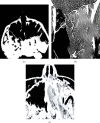Effect Evaluation of Preoperative Psychological Nursing Intervention on Sinusitis Patients Undergoing General Anesthesia by Multiplanner Reformation-Based CT
- PMID: 35936372
- PMCID: PMC9352500
- DOI: 10.1155/2022/7516339
Effect Evaluation of Preoperative Psychological Nursing Intervention on Sinusitis Patients Undergoing General Anesthesia by Multiplanner Reformation-Based CT
Retraction in
-
Retracted: Effect Evaluation of Preoperative Psychological Nursing Intervention on Sinusitis Patients Undergoing General Anesthesia by Multiplanner Reformation-Based CT.Comput Math Methods Med. 2023 Jul 19;2023:9876730. doi: 10.1155/2023/9876730. eCollection 2023. Comput Math Methods Med. 2023. PMID: 37503438 Free PMC article.
Abstract
The aim of this study was at exploring the clinical effect of CT images based on multiplanner reformation (MPR) combined with a preoperative psychological nursing intervention model in sinusitis patients undergoing general anesthesia. Sixty sinusitis patients who received MPR-based CT examination and general anesthesia were selected as the study subjects and randomly divided into the control group (n = 30) and the experimental group (n = 30). The control group used traditional preoperative education. The experimental group added the psychological nursing intervention based on traditional preoperative education. The blood pressure and heart rate before and after the operation, the self-rating anxiety scale (SAS) score before and after intervention, and satisfaction were comprehensively assessed. The results showed that CT based on MPR could observe the lesions and anatomical structures of the sinus wall and sinus in detail from multiple angles. The blood pressure (systolic blood pressure 135.12 ± 14.89 mmHg, diastolic blood pressure 87.05 ± 11.24 mmHg), heart rate (78.42 ± 12.19 beats/min), SAS score (45.85 ± 4.97 points), and nursing satisfaction (78.9%) of the experimental group were significantly better than those of the control group (145.83 ± 15.62 mmHg, 94.21 ± 10.86 mmHg, 86.44 ± 13.65 beats/min, 56.44 ± 5.12 points, 56.4%), and the differences were statistically significant (P < 0.05). In summary, the preoperative psychological care model has a positive role in reducing the tension and anxiety of patients before general anesthesia surgery and CT based on MPR is important for the clinical diagnosis and treatment of sinusitis. This study provides a theoretical reference for the clinical treatment of patients with sinusitis.
Copyright © 2022 Rong Zeng et al.
Conflict of interest statement
The authors declare no conflicts of interest.
Figures







Similar articles
-
Retracted: Effect Evaluation of Preoperative Psychological Nursing Intervention on Sinusitis Patients Undergoing General Anesthesia by Multiplanner Reformation-Based CT.Comput Math Methods Med. 2023 Jul 19;2023:9876730. doi: 10.1155/2023/9876730. eCollection 2023. Comput Math Methods Med. 2023. PMID: 37503438 Free PMC article.
-
Effect of teach-back health education combined with structured psychological nursing on adverse emotion and patient cooperation during 99mTc-3PRGD2.SPECT/CT.World J Clin Cases. 2022 Dec 6;10(34):12551-12558. doi: 10.12998/wjcc.v10.i34.12551. World J Clin Cases. 2022. PMID: 36579107 Free PMC article.
-
Chronic sphenoid sinusitis revisited: comparison of multidetector axial sections, multiplanar reconstructions, and virtual sinoscopy with endoscopic sinus surgery.Arch Otolaryngol Head Neck Surg. 2007 Jul;133(7):710-6. doi: 10.1001/archotol.133.7.710. Arch Otolaryngol Head Neck Surg. 2007. PMID: 17638786
-
The Effects of Health Education and the Sunrise Model of Nursing Care on Blood Pressure Control and Psychological Status in Elderly Patients with Hypertension.Altern Ther Health Med. 2025 Jan;31(1):288-293. Altern Ther Health Med. 2025. PMID: 38687864 Clinical Trial.
-
The Preoperative Sinus CT: Avoiding a "CLOSE" Call with Surgical Complications.Radiology. 2016 Oct;281(1):10-21. doi: 10.1148/radiol.2016152230. Radiology. 2016. PMID: 27643765 Review.
Cited by
-
Retracted: Effect Evaluation of Preoperative Psychological Nursing Intervention on Sinusitis Patients Undergoing General Anesthesia by Multiplanner Reformation-Based CT.Comput Math Methods Med. 2023 Jul 19;2023:9876730. doi: 10.1155/2023/9876730. eCollection 2023. Comput Math Methods Med. 2023. PMID: 37503438 Free PMC article.
References
-
- Nurchis M. C., Pascucci D., Lopez M. A., et al. Epidemiology of odontogenic sinusitis: an old, underestimated disease, even today. A narrative literature review. Journal of Biological Regulators and Homeostatic Agents . 2020;34(5 Suppl. 3):195–200. - PubMed
Publication types
MeSH terms
LinkOut - more resources
Full Text Sources
Medical

